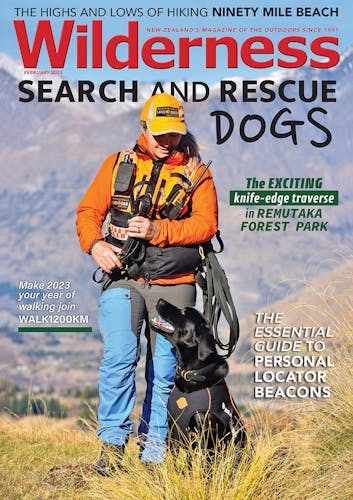Using a film camera allows you to savour a trip for months after it has ended. By Samantha Mythen
When I was young I devoted rainy days to exploring the outside world through photography.
Sinking into the cushions of the family couch, I’d spend hours flipping through photo albums of my parents’ adventures. In their early 20s (my current age) they paddled the Whanganui River, and on another occasion they crossed the sea trail of Abel Tasman National Park.
They carried well-thumbed maps, musty books and a 35mm Minolta film camera, and their photos made me nostalgic for an adventure without technology.
In the original National Geographic days, anyone could be an explorer. You didn’t have to be sponsored by The North Face or have a degree in ecology. There was so much to see and uncover. The world was full of wildness just waiting to be discovered. Getting lost usually meant making new friends who could point you in the right direction.
Explorers lived and breathed in the moment. Taking a photo was an afterthought.
But now, precious places can be geotagged and shared on social media. We view the world through a screen before seeing it with our own eyes. We’re distracted from the moment as we try to get the best angle for the shot.
One of my favourite things about going into the mountains is leaving my phone and the internet behind. I reconnect with my own rhythms. There’s nothing like going bush to sort your head out, my dad always says.
One day during university holidays, I discovered my parents’ old film camera tucked away at the back of a cupboard and made a decision. My best partner in crime and I set off on our own adventure, the Minolta in hand.
Off-season, we kayaked the Abel Tasman. For four days we saw no one. We had an entire campsite to ourselves and every day we washed in the ocean. I was often too busy kayaking to think about the camera, and anyway, taking it out of its waterproof bag would have put it at the mercy of my clumsy paddling. The 60km journey passed at a leisurely pace. The water was so blue, it was hard to tell where the sea ended and sky began.
Impressed by the fact we didn’t flip the kayak, we decided to retrace my parents’ adventure and canoe the Whanganui River.
We paddled for five or six hours every day. Our arms felt detached from our bodies as we pulled into each day’s campsite. There were rapids to navigate. We had to work as a team. We definitely argued, but we also sang. No Spotify or speakers in sight.
On these two journeys I had just one film roll: 24 photos. I had to pick my moments wisely. More often than not, though, I left the camera in its case in order to focus on the moment.

It took months to get my film developed. But this slow process of revealing a memory turned out to be another joy of film photography. When I got the call that my photos had been developed, I could hardly wait to collect them.
With a digital photo, everything is in sharp focus. Intricate details are perfectly framed. It’s a spotlight on a moment. You upload the photos to your laptop and look at them at once every five years. Often, there are a dozen of the same scene.
It’s different with 35mm film. It captures not just a place but feelings. With a limited amount of film, you see your moment and grab it. No time to worry about getting the perfect angle.
You can’t instantly upload film photos to social media either. But it doesn’t matter so much whether other people know you’ve done something cool: the adventure is all yours.
A film photo may have watermarks, a thumbprint, and a thumb in the picture. Blurred and maybe out of focus. The light is not quite right. But it pulls you back to the exact moment the photo was taken.
At the camera shop, not wanting to seem too eager, I tucked the envelope into my bag. In the middle of Christchurch’s Hagley Park, I pulled out the photos and there I was, back in the middle of two national parks.
The feeling of waking in a campsite all by ourselves. Bellbirds and the lapping sea. Sunshine defrosting our piece of paradise. The chill mist wrapping around our bodies as we waited for the sun to burst through after an early morning swim. The joy of looking back in the canoe into the smiling face of someone I loved. Magic.







